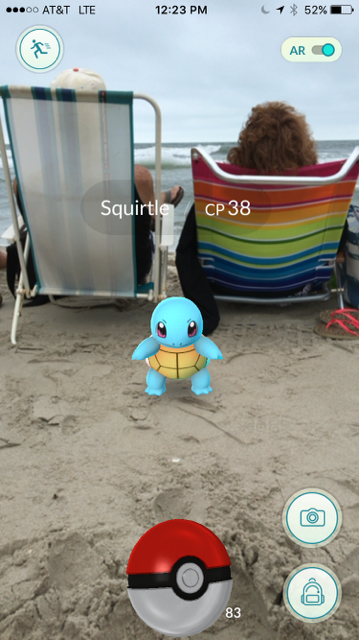If you’ve logged onto Facebook, checked your cell phone, read a newspaper, watched television or generally accessed any form of media whatsoever since July 6, there’s a good chance you’re aware of the Pokemon Go phenomenon that is sweeping the nation. If you haven’t heard of it, you might want to pull out your phone and check if that rock you’re living under is a Graveler or an Onix, they’re pretty rare and it’s probably worth lobbing a few Pokeballs their way.
The debut of the augmented reality game in early July has been a huge highlight for the franchise in 2016, the 20th anniversary of Pokemon. With download and daily play numbers that are breaking records across devices, the Pokemon franchise has shown no signs of slowing down any time in the relatively near future.
Pokemon Go is only the latest and greatest from Pokemon, but is hardly a “revival” or “resurgence;” for 20 years, Pokemon has captivated audiences of various ages, races and locations, bringing together different cohorts with a common goal: to catch ‘em all. Since the debut of the games, sales and viewership numbers have continuously grown as the interest in Pokemon

Pokemon fans can capture any and all of the original 151 Pokemon in Pokemon Go.
Stepping back to 1996 gives you a picture of Pokemon in its infancy. The franchise got its feet wet with the debut of two games for the Gameboy, Pocket Monsters Red and Pocket Monsters Green, both released in Japan. The games were revamped, upgraded and translated for release in the United States two years later under the names Pokemon Red and Pokemon Blue. Those games, combined with the subsequent release of Pokemon Yellow, make up the first generation of Pokemon handheld games. This November the seventh generation will hit shelves, proving that today, 20 years after release, Pokemon games are as highly-received, widely-desired and continue to drive as much revenue as they ever have in the past.
Those games–the defining features of the franchise to many–only scratch the surface. They don’t include the various spin-off games and side-series games that also garnered heavy attention and praise from critics. The games are some of the biggest players in the wide, wide world of Pokemon, but the 20-year history extends far beyond just video games.
The Pokemon animated television show was a huge hit for years and was the basis for numerous movies that saw both theatrical and home releases. The trading card game has found similar success having sold __ since their release. Obvious trademarked merchandise like plush toys, action figures and decorations have been sold throughout the duration of the Pokemon frenzy, but less-obvious and less common Poke-related items, events and offerings have popped up.
Pokemon: Symphonic Evolutions is a new and ongoing concert series that performs around the world. Walking viewers and fans of all ages through the Pokemon video game series through the power of an entire orchestra has caught the interest of fans of the series.

Pokemon Symphonic Evolutions plays at the Mann Center in Philadelphia.
In short, Pokemon, at the ripe age of 20, could just be hitting its stride. As new technology finds its way into the market more and more organizations–and franchises–are finding ways to capitalize on them and captivate audiences both young and old, new and returning. While the age of the franchise itself is getting steadily older, the age of the typical user is following suit. As you may expect from a franchise that marketed itself primarily to a younger audience upon its debut, the average age of buyers of the handheld games is growing along with the franchise.
Pokemon Go did little to break that trend, as the user-base for the new game is both varied in its audience age and its gameplay. While children of all ages are playing the game, so are adults. It’s spawned an Adult’s Guide to Pokemon Go from Buzzfeed and Quora questions in which adults come vehemently to the defense of other adults playing the game. For most, however, there is no shame. Facebook statuses and Tweets have been popping up in timelines almost nonstop since the game’s release, showing screen captures of rare Pokemon users have caught, unlikely places they’ve found them and the gyms they’ve captured.
At its core, the game is both a revolution in augmented reality gaming as well as a way for socializing, making friends and rediscovering a love for the Pokemon franchise.
The game–which is a free download on both the Android and Apple app stores–urges players to, well, go. To capture Pokemon, users have to roam their neighborhood,
finding the characters on real-life streets, inside of buildings and in rivers, fields and even oceans. By tracking down the Pokemon using the phone’s GPS system and the map overlay, users can find them, see the Pokemon on the screens of their smartphones, and throw virtual Pokeballs at them to add them to their collections. Though the battling functionality that the lovers of the original handheld and card games have come to expect is not quite there, users are able to take over Pokemon Gyms, evolve their Pokemon and level up by using in-game items.
Already, just over a week since its release, Pokemon Go is being used actively longer than apps like Instagram and has been downloaded almost as many times as Twitter, two absolute giants in the mobile app world. It is, in a word, a revolution. People knew the app was coming, and there was predictable excitement. But the absolute explosion of Pokemon Go is a huge testament to the reputation of the Pokemon franchise. For decades, children (and adults, admittedly) have dreamt of finding and catching Pokemon in the real world. Pokemon Go has begun to make that dream a reality for some. And while the Pokemon franchise as a whole has been far from falling, dipping or in need of a resurgence, Pokemon Go has done an incredible job of putting Pokemon back in the mainstream news time and time again.
Great TV shows like The Simpsons can point to their longevity when asked about successes and sources of pride. For 27 seasons, the animated hit has been broadcast to viewers of all ages across the globe. Pokemon is living out a very similar, albeit far more revolutionary, life right now. Having been around for 20 years, Pokemon has continued to evolve, grow its brand and engage new audiences. For the Pokemon franchise, this could be the start of a Pokerevolution.

A Squirtle appears on the sand behind unsuspecting beach-goers.

